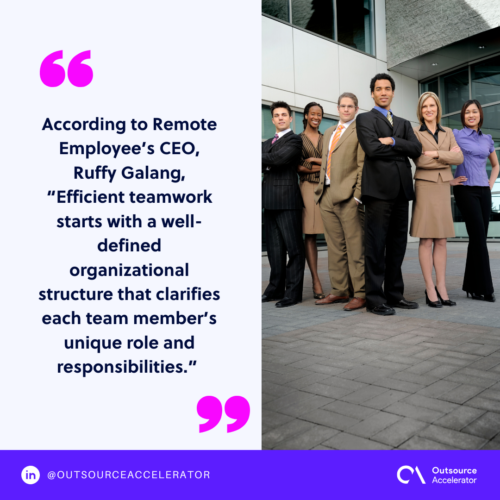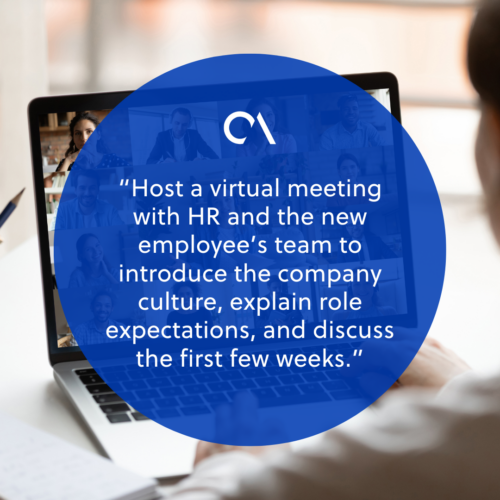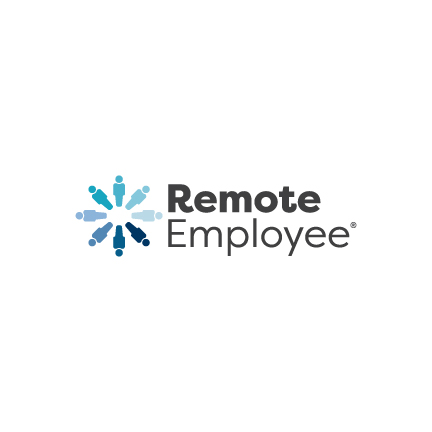How to onboard a remote employee? 5 steps for a smooth transition

Onboarding a remote employee
The US Bureau of Labor Statistics reported that 35% of full-time employees worked remotely in 2023. As this is an increase from the previous year’s measure, it reinforces the idea that remote work is a valid set-up.
Onboarding remote employees requires a well-structured process to ensure they feel welcomed, equipped, and ready to succeed. But many young firms deal with the challenge of how to onboard a remote employee.
Due to the lack of face-to-face interaction in remote work, this can be more challenging than in-office onboarding. But with the right steps in place, it can be equally effective.
According to Remote Employee’s CEO, Ruffy Galang, “Efficient teamwork starts with a well-defined organizational structure that clarifies each team member’s unique role and responsibilities.”
Let’s explore the importance of structured onboarding and walk through key steps to onboard remote employees seamlessly.
We’ll also highlight how partnering with companies like Remote Employee can help streamline the process.

Importance of a structured onboarding process
A 2023 Paychex survey found that only 53% of employees were satisfied with their latest onboarding. From the beginning, this was cited as a possible reason for high turnover later on.
A structured onboarding process is critical to setting up remote employees for success. It helps new hires understand their roles, connect with their teams, and acclimate to the company culture.
Well-planned onboarding improves employee engagement, boosts retention rates, and shortens the time it takes for new hires to reach full productivity.
Remote employees face unique challenges. If not addressed properly, these can lead to confusion and disengagement.
The chart below shows the top three remote employee productivity challenges and how they affect workers:
| Remote productivity challenge | How it affects workers |
| Communication barriers | Misunderstandings or lack of clarity can occur without face-to-face interaction. |
| Distractions at home | Home environments can be full of distractions, impacting focus and efficiency. |
| Feelings of isolation | Remote work can lead to loneliness, impacting motivation and engagement. |
A clear, supportive onboarding process can bridge these gaps, ensuring that employees feel part of the company even when working from a distance.
Additionally, successful onboarding creates a positive first impression. This can strengthen an employee’s long-term commitment to the organization.
How to onboard a remote employee: 5 easy steps
Let’s go through the steps for how to onboard a remote employee:
1. Pre-onboarding preparation
The onboarding journey begins before the employee’s first day. Early preparation ensures that everything is in place to give the new hire a smooth start.
Here are some essential steps:
Send a welcome email
Welcome emails should include important information such as an overview of the company, details about the role, and a schedule for the first week.
This helps new hires feel informed and ready for their upcoming tasks.
Set up tools and technology
Ensure that the new employee has access to all necessary tools. These can include email, communication platforms, and project management software.
IT support should be available to help set up accounts and troubleshoot any technical issues before their first day.
Prepare onboarding materials
Provide documents such as the employee handbook, training manuals, and company policies.
Having these materials ready ensures that the employees can familiarize themselves with company guidelines and procedures right away.
2. First-day onboarding
The first day sets the tone for the employee’s experience at the company.
Here’s how to make the first day as welcoming as possible:
Welcome meeting with HR and team
Host a virtual meeting with HR and the new employee’s team to introduce the company culture, explain role expectations, and discuss the first few weeks. This gives the employee a sense of belonging from the start.
You may need to adjust at the beginning for remote employees in different time zones, but this will contribute to a stronger onboarding.

Virtual office tour
While remote employees won’t have a physical office, a virtual tour of the company’s digital spaces can be just as important.
Show how workflows operate, demonstrate how to use collaboration tools, and introduce key teams and departments.
Schedule one-on-one meetings
Organize individual meetings with the new hire’s direct supervisor and other key team members. This helps build relationships and gives the employee a clearer understanding of the team’s dynamics.
3. Training and development
Effective training is crucial to helping remote employees gain the skills they need to thrive in their new roles.
Provide role-specific training
Whether it’s learning new software or understanding how the team works, providing tailored training will help remote employees get up to speed quickly. Ensure they have access to all the resources they need, and schedule regular check-ins to track progress.
Assign a mentor or buddy
Pair the new hire with an experienced team member who can provide day-to-day support.
A mentor not only helps the new employee navigate their tasks but also offers a friendly face to help them acclimate to the company culture.
Many Fortune 500 companies have seen the value of this, with a MentorcliQ report finding that 98% offered mentoring programs.
Set learning milestones
Outline goals for the first week, month, and quarter. This gives the employee clear objectives to work towards and helps management track progress.
4. Communication and check-ins
Strong communication is key to the success of remote teams. Since remote employees can’t drop by a manager’s office with questions, it’s important to establish a communication framework.
Schedule regular check-ins
Regular meetings with the employee’s supervisor ensure that any questions or concerns are addressed.
It’s also a good time to give and receive feedback about the onboarding experience.
Encourage open communication
Make sure the new hire knows who to contact for specific questions and feels comfortable reaching out for help. Use a mix of communication channels to keep communication lines open.
Foster team engagement
Remote employees may feel isolated from the rest of the team, so it’s important to schedule virtual team-building activities.
Encourage informal social interactions by creating virtual spaces for casual conversations, like virtual coffee breaks or team chats.
5. Assessing and improving the onboarding process
A successful onboarding process is not a one-time event but an ongoing effort that evolves over time.
Collect feedback
After the onboarding process, ask the new employee for feedback. A survey or informal interview can help identify any areas for improvement.
Monitor progress
Remote work offers several benefits, but you must be willing to take the steps to build towards them.
Regularly check in on the employee’s performance and ensure they are meeting the milestones set during training. Provide constructive feedback and make adjustments to help them succeed.
Continuous onboarding
Even after the initial onboarding period, continue to provide opportunities for learning and development.
This helps remote employees grow in their roles and stay engaged over the long term.

Partner with Remote Employee
Onboarding remote employees can be a complex process, especially for companies without dedicated resources for remote work.
Partnering with an experienced provider like Remote Employee can help companies navigate these challenges and ensure a smooth onboarding experience.
Remote Employee specializes in offering tailored solutions for onboarding. The company covers access to remote tools, structured training programs, and communication support.
Companies can focus on core business operations while ensuring that their remote hires are set up for success from day one. Remote Employee also provides ongoing support to help employees transition smoothly into their roles and continue to develop within the company.
Find a professional remote employee today!







 Independent
Independent




